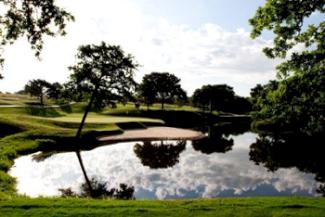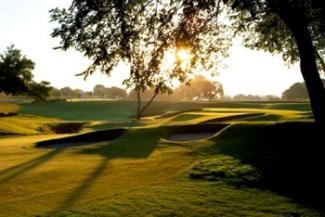Featured Golf News
Revived Oak Tree National Demands its Pound of Flesh
I heard the stories about Oak Tree National: expect to be humbled even if you're at your best. That's the way the course was designed by Pete Dye, whose directive in 1974 was to make Oak Tree Golf Club (as it was named then) the "hardest golf course in the world."

The 4th Hole at Oak Tree National
That edict was ramped up even more in 2002 when the track in Edmond, Okla., was updated with redesigned greens, more length and additional tees, and then again when the course was renovated over the 10 months preceding July 2009, as 22 bunkers were added and eight greens on the back nine were reshaped.
The most recent changes have enhanced the Dye-designed features that the club's new owners (led by Oklahoma businessman Ed Evans) were seeking. Every fairway and bunker was redone as Evans' ownership group sought to put the course back to its original condition when Dye designed it, and the greens were modified to play more like they did when the course opened. And there are also some modern updates, including the planting of U-3 Bermuda turf on the fairways and laser-leveling each tee box.
The efforts paid off in August, when the newly named Oak Tree National was awarded the 2014 U.S. Senior Open, the latest major tournament to be scheduled for the ballyhooed club. In the past the club hosted the 1984 U.S. Amateur, 1988 PGA Championship and 2006 Senior PGA Championship.
"We believe we will have a great test of golf for this national championship," Evans said. "For a golf course that is relatively young, it has already built up quite a resume of significant events. We have been given the chance to get back on the national map."
In my mind, Oak Tree National's constant challenge and its mystique of difficulty never left. And after playing the par-71, 7,410-yard course I can tell you that I did get beat up. But I can't wait to take another crack at it if given the opportunity.
The track has everything a real golfer wants: sand and water and trees and length and thick rough and fiercely contoured greens and, because this is central Oklahoma, constant wind. Miss the putting surfaces by just a little and you'll pay a price, either from the water hazards or the deep bunkers, but mostly from downhill and uneven lies played to elevated greens.

The 16th Hole Greens Complex
Once you've heard and read so much about Oak Tree National, teeing it up on the course - which has a 79.3rating and a 155 slope (the maximum) from the tips - can be even more daunting. Standing on the tee for the 451-yard, par-4 first hole just adds to your consternation.
Traditional course architecture calls for a relatively straightforward, even easy opening hole; sort of a warm welcome. Not Oak Tree National. Here, the welcome mat is an immediate warning that most mortals have to play as a par-5. The drive plays downhill to a fairway that kicks everything to the left. If the ball goes too far in that direction, the second will have to be played from rough, over a lake, sand, trees and then more sand to a green only a few steps wide. Imagine that into a wind - or even downwind, and you'll understand why even some of the pros lay up short of the green and hope for a pitch-and-putt par.
Dye's favorite hole at Oak Tree National is the 597-yard third, an unreachable par-5 where the second shot must be played carefully around the right-to-left dogleg, with water down the entire left side. The wedge approach must be a good one since the green is one of the smallest on the course and is guarded in front by a cavernous pot bunker.
The fourth is the first of Oak Tree National's vaunted par-3s. At 206 yards, with 190 of that carry over water, the green is bulk-headed with several dozen native red rocks, a change from the Dye-signature railroad ties that originally engirded the green.
No. 5 at Oak Tree National sports the huge tree that gives the course its name. A 592-yard par-5, it calls for a drive straight over the top of that namesake. Despite its length, the hole is reachable in two by long hitters as its last half plays slightly downhill and roll-on shots are possible. But so are roll-off approaches; the small target sits on a peninsula ringed first by sand, then water.
The best birdie opportunity on Oak Tree National's front nine may be the 411-yard sixth, but to do so it's necessary to avoid the deep bunkering on the right. Trouble returns at the 462-yard seventh, where the only way to shorten the dogleg-left is to hug the trees, rough and water on the left.
The front side ends with the longest par-4 on the course. At 480 yards, it plays into a prevailing south wind, and the tee shot must finish high on a plateau to leave a reasonable shot to the green. The putting surface, elevated on all sides, is flanked by a huge "graveyard" bunker along the right and a grass bunker to the left.
The inward nine lists four par-4s in excess of 457 yards. No. 11 stretches to 466 and reaches out to an elevated green with a nearly 10-foot-deep bunker left. The hole, ranked the course's No. 2 handicap, was named by the PGA of America as the toughest 11th hole in the country. Yet I think the 471-yard par-4 12th is even tougher, playing through a rolling valley to a green framed by bunkers and trees.
No. 13 is the course's famed "postage stamp" par-3, playing a relatively mere 171 yards to a long, narrow green ringed by a creek left and behind. The 13th was unlucky for Seve Ballesteros in 1988. In the second round of the PGA Championship, his tee shot overflew the green and the Spaniard found his ball lying in a creek bed just a few feet from the 4-foot high stone wall that supports this green. Attempting a quick-rising cut shot, he skulled the ball into the wall. It nearly hit him on the rebound before settling in some thick brush. From there he needed three more strokes to reach the green, where he sank a 10-footer for a triple-bogey 6. Seve shot a 75 and missed the cut.
The 15th, a 472-yard par-4, is one of the most underrated holes on the course. The drive must be placed in the fairway to allow an approach to find its way through a chute of large oaks. It's followed by the 538-yard 16th, where birdies are frequent. The green, however, is protected left by two huge bunkers and a creek, and the fast split-level green presents all sort of chipping challenges. This hole used to have a hangman's noose in a tree to the left of the green, but both have now been removed and replaced by a different tree.
The round ends with two of Oak Tree National's toughest holes. Like the three other par-3s, No. 17 plays entirely over water, this time to a very shallow and wide green where club selection can vary three clubs or more depending on pin placement. A beach bunker, stretching into the water, is on the right side, but the huge grassy mounds left are places to be avoided at all costs.
The adventure concludes with the stunning 18th, nicknamed "the Valley of Sin." At 436 yards, the hole plays into the prevailing wind. Its three-tiered green is fronted by a deep bunker that needs to be considered back on the tee.
Along with the on-course changes, Oak Tree National also unveiled an impressive teaching facility, which features state-of-the-art technology and one of Golf Magazine's Top 100 Teachers, E.J. Pfister.
With Pfister's help, golfers can access equipment such as the SAM PuttLab, which measures 28 parameters of a person's putting stroke with ultrasound technology, and the K-Vest, which is attached to a person's upper and lower spine and hands to give a 3-D image of the swing. Also on hand are a putting studio, a club repair area and the first and only HD video-analysis software ever purchased. The key piece of equipment at the teaching facility is the $32,000 TrackMan launch monitor. Its Doppler system shows the characteristics of launch angle, spin rate and club shaft and how they relate to the golf swing. This is used by all the major manufacturers to fit PGA Tour pros.
"Very few clubs in the country have the comprehensive technology Oak Tree National has," Pfister commented. "The closest facility that is comparable to Oak Tree National is the Titleist Performance Institute in Carlsbad, California."
When Oak Tree National debuted, Dye regarded it as the "finest inland golf course he has ever built." At that time, it was named one of "America's 100 Greatest Courses" by Golf Digest and was the youngest course to receive such an honor. Through the years, Oak Tree National has continued to receive kudos, with holes Nos. 3, 4 and 16 earning spots on Golf Digest's list of "America's Top 99 Greatest Holes."
There's no doubt this course is one of the nation's true gems. Before tee off, however, be sure to check your ego at the gate and be prepared to take your medicine.
For more information, visit www.oaktreenational.com.
Steve Habel is one of Cybergolf's national correspondents, contributing news stories, features, equipment and book reviews and personality profiles from his base in Central Texas. He is also the managing editor for Business District magazine in Austin and works as a contributing editor for Horns Illustrated magazine, a publication focusing on University of Texas sports. He also writes a blog (www.shotoverthegreen.blogspot.com), which features news on golf and the Longhorns.
Story Options
 |
Print this Story |
